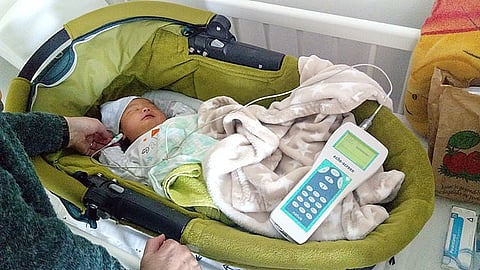

Did you ever imagine your life with eerie silence, a world without a melodious birds chirping, the soothing sounds of raindrops, a gentle conversation with people, no music, no laughter but just silence? But it is a reality for people living with hearing impairment.
Congenital hearing impairment is defined as a hearing loss present from birth which is a chronic condition observed in children. There are various factors involved in newborns with hearing impairment which includes: Genetics, birth injuries, infections (such as HSV/Rubella), premature birth, preeclampsia, anoxia., etc.1 However, genetics play the major in hearing impairment, where 50% cases are mostly related to it. Carrier gene may be from both the parents or anyone of them or may be formed due to mutation.
Role of early screening in detection of congenital hearing impairment:
Hearing plays a major role in learning to talk. Without hearing and speech, it is difficult to develop and maintain interpersonal relationships. In late 1950’s, the standard approach was to delay prescribing personalised hearing aids for hearing impaired children until they had developed adequate speech skills. Significant advancements in understanding child auditory system development, socio-emotional growth and hearing technologies have transformed the approach to hearing impairment.
Today early detection and identification are considered critical for optimal outcomes. Since 2009, Germany has ensured newborn hearing screening nationwide, following a Federal Joint Committee ruling. Similarly, many European countries (Austria, Great Britain, Italy, France) and Asian nations, as well as the US, have adopted Universal Newborn Hearing Screening (UNHS), either as a recommendation or legal requirement.2
Before implementing a system for early detection of hearing impairment in newborns and infants, 3 key issues must be addressed:
1. Cause of hearing impairment: Hereditary/non hereditary/congenital.
2. Type of hearing impairment: Nature (conductive, sensorineural or mixed hearing loss) and Location (middle ear/inner ear/unilateral or both).
3. Degree of hearing impairment: Decibel level (dB) and Classification (mild (25–40 dB), moderate (41–70 dB), severe (71–90 dB), profound hearing loss (> 91 dB)).3
MedBound Times reached out to Dr Neha Sood on her insights on congenital hearing impairment.
However, unfortunately it is not followed in smaller centres or the smaller towns and villages. More active reach to interiors and facilities should be made available by the government. Along with this, more active educational activities are the need of the hour to enlighten general public and health care professionals about why early diagnosis is important and why treatment is important as early as possible. Hearing loss in children is considered as a ‘Neuro developmental emergency’ said Dr Neha Sood.
Newborn hearing screening process typically involves:
Oto-acoustic emissions (OAE) testing, repeated twice.
Combination of Oto-acoustic emissions (OAE) and automated auditory brainstem response (AABR) testing or Automated auditory brainstem responses testing (AABR), repeated twice.
Infants failing the screening require comprehensive audiological and medical assessments to confirm hearing loss, ideally within 3 months. However, passing the neonatal screening does not rule out progressive hearing loss, late onset hearing loss and mild to moderate congenital hearing impairment.
Infants with risk factors or parental concerns require regular follow-up, as hearing loss can develop later due to underlying causes. Following neonatal screening referral, a comprehensive audiometric assessment confirms hearing loss, determines severity, and identifies laterality. Early detection and intervention of hearing loss mitigate the risk of subsequent disabilities which includes language delays, learning disabilities and cognitive disorders.4
Dr Neha says it is mandatory to treat children with profound loss before 5 yrs of age. Since after that because of the concept of neural plasticity, the speech development even if treated is not good.
Stay tuned for (part 2) to learn more about Types of diagnosis and Treatment for restoring Congenital Hearing Impairment.
References:
American Speech-Language-Hearing Association. "Congenital Hearing Loss." Accessed November 22, 2024. https://www.asha.org/public/hearing/congenital-hearing-loss/.
Morton, Cynthia C., and William E. Nance. "Newborn Hearing Screening—A Silent Revolution." New England Journal of Medicine 354, no. 20 (2006): 2151–2164. Accessed November 22, 2024. https://www.ncbi.nlm.nih.gov/pmc/articles/PMC3139414/.
Yoshinaga-Itano, Christine, et al. "Early Hearing Detection and Intervention: A Global Perspective." Pediatrics 148, no. 1 (2021): e2021053431. Accessed November 22, 2024. https://www.ncbi.nlm.nih.gov/pmc/articles/PMC10278076/.
Stevens, Gretchen, et al. "Global and Regional Hearing Impairment Prevalence: An Analysis of 42 Studies in 29 Countries." Journal of Hearing Research 310 (2014): 1–12. Accessed November 22, 2024. https://www.ncbi.nlm.nih.gov/pmc/articles/PMC5675031/.
MSM
